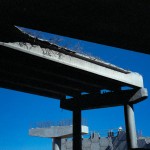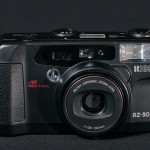Ricoh RZ-3000
The Ricoh RZ3000 may be the best form factor for a film zoom point and shoot camera. While it is a larger than the Canon 180u or any of the Olympus Stylus cameras, it feels good in the hand. It has a nice grip on the right side that makes carrying it in your hand easy. The other reason is the top plate dials for changing modes, most of the other cameras like this have small rubber buttons that are hard to press accurately and only provide feedback via an LCD. With the dials the available exposure modes can be easily set and the large flash control button is separate and distinct. Another nice feature of the dials is the selected mode is illuminated with a pleasing glow making it easy to know how the camera is set when in dim light.
The lens is a 38 to 130mm f4.5 to 9.5 with aspherical elements (6 elements in 3 groups)
Ricoh describes the auto-focus as having 7 zones with 1024 steps. The camera also has an infinity mode selected via the top dial and a single center focus point mode. Other modes are portrait where the camera sets the flash to fire for fill and sets single focus point automatically. The zoom also automatically changes to frame the person with a half press of the shutter. Action mode sets auto-focus to single point and the drive mode to continuous.
The major detraction is the lack of any exposure overrides, all exposure is handled by the camera. I have only run one roll of film through the camera and it was some very poor Polaroid 400 that was at least 10 years out of date. The point was to test that it worked before committing to using good film that is becoming even more precious.
I’m intrigued enough with this camera to give it another try with better film. Until then here are some sample images from that initial roll.











October 13th, 2012 at 9:21 am
When is this model set to come onto the market? I might get one!
October 13th, 2012 at 1:18 pm
It is not for you Duncan, it is too special.
July 16th, 2013 at 8:02 am
[…] do I feel now? Well it’s a good camera with great ergonomics as I outlined in my first post Ricoh RZ3000 , but as for results it doesn’t produce anything that necessarily stands out. I could go back […]
July 31st, 2013 at 1:12 am
A bit late to comment on a camera that certainly lives well below the radar. I ran a roll of Superia 400 through it and surprisingly for a consumer P&S camera with a slow zoom lens, results were very good. Sharpness was not something to rave about, but the overall feel is that of a fixed-lens camera.
I particularly liked the rendering of this one, although I cannot pin-point on the exact element of the image that makes me happy, most of all I guess is the nice color rendition.
http://www.flickr.com/photos/deafburglar/8719549425/in/set-72157632069830445
July 31st, 2013 at 6:35 am
Christos it’s never too late. At times I find there is little to no information about a camera so I just write about it informally. I concur with your assessment of the camera and its lens
August 23rd, 2013 at 4:59 pm
This beast seems to have been released in 1997. It was preceded by the Shotmaster 130Z in 1996 which is identical.
There was also a Shotmaster 130 Super QD in 1996 which is only cosmetically different.
November 10th, 2017 at 7:50 pm
This is quite old as far as i remember it was released in 1997 after Shotmaster 130Z no?
June 10th, 2018 at 3:09 pm
[…] The Ricoh RZ3000 for what it is can only really be faulted for its need for specific expensive batteries otherwise it is a fantastic camera. It takes two CR123-A batteries to power it. The RZ3000 has a seven focus point AF system although they are clustered in the center it is more than the 3 offered by most of the competitors at the time. And better yet if you want to use a single central focus point it can be selected on the main operating dial rather than through some presses of a small button. You can also set the focus to infinity with the main dial which is convenient when shooting through glass or when you want to make sure the camera doesn’t lock focus on something in the foreground. The lens on the RZ3000 is a 38-135 f 4.5-f9.5 six element in three groups. So I guess that could be added to the fault list as 38mm isn’t as wide as I like a lens to start but the trade off tends to be overall image quality. I’ve written about this camera before here Ricoh RZ3000 […]